The enigmatic interior of black holes has puzzled scientists for decades. First conceptualized by German physicist Karl Schwarzschild in 1916, the singularity at the center of a black hole presented a staggering challenge to the foundations of physics. The singularity, a point where space and time cease to exist, was believed to suspend all known laws of physics, including Albert Einstein’s theory of general relativity. This made it nearly impossible for any information to escape beyond the event horizon, rendering the study of black holes exceptionally difficult. However, recent advancements in astrophysics have unveiled an alternative celestial object, known as the gravastar, which presents a fascinating solution to the conundrum of black hole interiors.
In 2001, physicists Pawel Mazur and Emil Mottola proposed an intriguing concept called gravastars. These objects, derived from an alternative solution to Einstein’s field equations, possess properties akin to those of black holes but diverge in several crucial aspects. Gravastars, much like black holes, exhibit remarkable compactness and possess an intense gravitational force at their surface. However, unlike black holes, they lack an event horizon and do not harbor a singularity at their core. Instead, gravastars are composed of an exotic form of energy, often referred to as dark energy, which counteracts the immense gravitational pressure. The surface of a gravastar consists of an infinitesimally thin layer of ordinary matter.
Taking inspiration from the concept of gravastars, theoretical physicists Daniel Jampolski and Professor Luciano Rezzolla from Goethe University Frankfurt recently introduced the idea of a new celestial object, the nestar. This hypothetical object features a gravastar contained within another gravastar, resembling a matryoshka doll. The research, published in the journal Classical and Quantum Gravity, provides a novel solution to Einstein’s field equations and outlines new possibilities in the study of these nested celestial bodies.
According to Daniel Jampolski, the discovery of the nestar arose during his Bachelor’s thesis, under the guidance of Professor Luciano Rezzolla. Jampolski explains that the nestar possesses multiple layers of nested gravastars, each enclosed within the other. While the original concept proposed by Mazur and Mottola suggested an infinitely thin outer shell of ordinary matter for gravastars, the nestar’s outer shell exhibits a slightly thicker composition. This modified structure grants a degree of plausibility to the existence of nestars, making them easier to envision.
The introduction of nestars and the exploration of nested gravastars present exciting prospects for astrophysics. Luciano Rezzolla describes the discovery as akin to finding a gold coin in a path previously explored by numerous scientists. It emphasizes the continual advancements in our understanding of the universe, even a century after Schwarzschild’s groundbreaking solution to Einstein’s field equations. However, despite these remarkable findings, the origin and creation of gravastars, including nestars, remain an enigma, challenging researchers to delve further into this fascinating realm.
The interior of black holes has mystified scientists for over a century, with the singularity acting as an impenetrable barrier. However, the emergence of gravastars has provided a tantalizing alternative to better comprehend these celestial wonders. With the introduction of nestars, the nested gravastar phenomenon uncovers a universe rife with complexity. As researchers continue to unravel the mysteries of the universe, nestars serve as a reminder that there is still much to explore and discover in the depths of space.


Leave a Reply